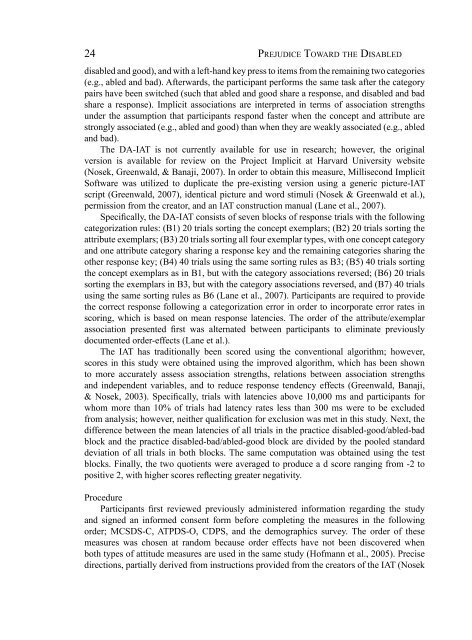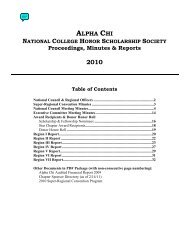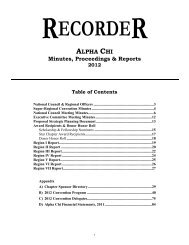Vol. 52, No. 1, 2009 - Alpha Chi
Vol. 52, No. 1, 2009 - Alpha Chi
Vol. 52, No. 1, 2009 - Alpha Chi
You also want an ePaper? Increase the reach of your titles
YUMPU automatically turns print PDFs into web optimized ePapers that Google loves.
24<br />
Pr e j u d i c e To wa r d t h e Di s a b l e d<br />
disabled and good), and with a left-hand key press to items from the remaining two categories<br />
(e.g., abled and bad). Afterwards, the participant performs the same task after the category<br />
pairs have been switched (such that abled and good share a response, and disabled and bad<br />
share a response). Implicit associations are interpreted in terms of association strengths<br />
under the assumption that participants respond faster when the concept and attribute are<br />
strongly associated (e.g., abled and good) than when they are weakly associated (e.g., abled<br />
and bad).<br />
The DA-IAT is not currently available for use in research; however, the original<br />
version is available for review on the Project Implicit at Harvard University website<br />
(<strong>No</strong>sek, Greenwald, & Banaji, 2007). In order to obtain this measure, Millisecond Implicit<br />
Software was utilized to duplicate the pre-existing version using a generic picture-IAT<br />
script (Greenwald, 2007), identical picture and word stimuli (<strong>No</strong>sek & Greenwald et al.),<br />
permission from the creator, and an IAT construction manual (Lane et al., 2007).<br />
Specifically, the DA-IAT consists of seven blocks of response trials with the following<br />
categorization rules: (B1) 20 trials sorting the concept exemplars; (B2) 20 trials sorting the<br />
attribute exemplars; (B3) 20 trials sorting all four exemplar types, with one concept category<br />
and one attribute category sharing a response key and the remaining categories sharing the<br />
other response key; (B4) 40 trials using the same sorting rules as B3; (B5) 40 trials sorting<br />
the concept exemplars as in B1, but with the category associations reversed; (B6) 20 trials<br />
sorting the exemplars in B3, but with the category associations reversed, and (B7) 40 trials<br />
using the same sorting rules as B6 (Lane et al., 2007). Participants are required to provide<br />
the correct response following a categorization error in order to incorporate error rates in<br />
scoring, which is based on mean response latencies. The order of the attribute/exemplar<br />
association presented first was alternated between participants to eliminate previously<br />
documented order-effects (Lane et al.).<br />
The IAT has traditionally been scored using the conventional algorithm; however,<br />
scores in this study were obtained using the improved algorithm, which has been shown<br />
to more accurately assess association strengths, relations between association strengths<br />
and independent variables, and to reduce response tendency effects (Greenwald, Banaji,<br />
& <strong>No</strong>sek, 2003). Specifically, trials with latencies above 10,000 ms and participants for<br />
whom more than 10% of trials had latency rates less than 300 ms were to be excluded<br />
from analysis; however, neither qualification for exclusion was met in this study. Next, the<br />
difference between the mean latencies of all trials in the practice disabled-good/abled-bad<br />
block and the practice disabled-bad/abled-good block are divided by the pooled standard<br />
deviation of all trials in both blocks. The same computation was obtained using the test<br />
blocks. Finally, the two quotients were averaged to produce a d score ranging from -2 to<br />
positive 2, with higher scores reflecting greater negativity.<br />
Procedure<br />
Participants first reviewed previously administered information regarding the study<br />
and signed an informed consent form before completing the measures in the following<br />
order; MCSDS-C, ATPDS-O, CDPS, and the demographics survey. The order of these<br />
measures was chosen at random because order effects have not been discovered when<br />
both types of attitude measures are used in the same study (Hofmann et al., 2005). Precise<br />
directions, partially derived from instructions provided from the creators of the IAT (<strong>No</strong>sek









